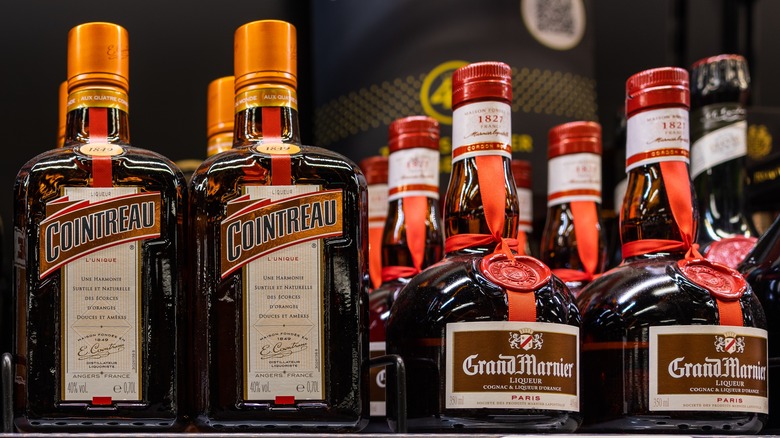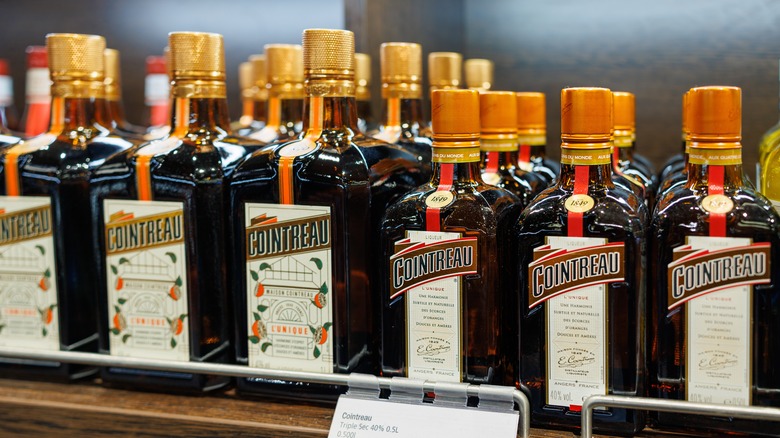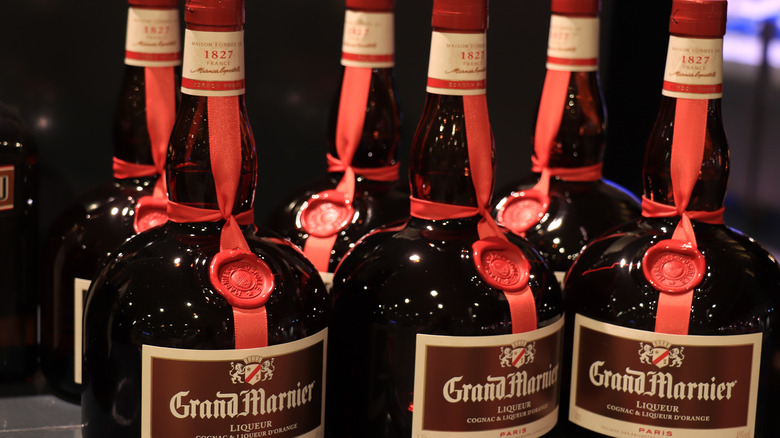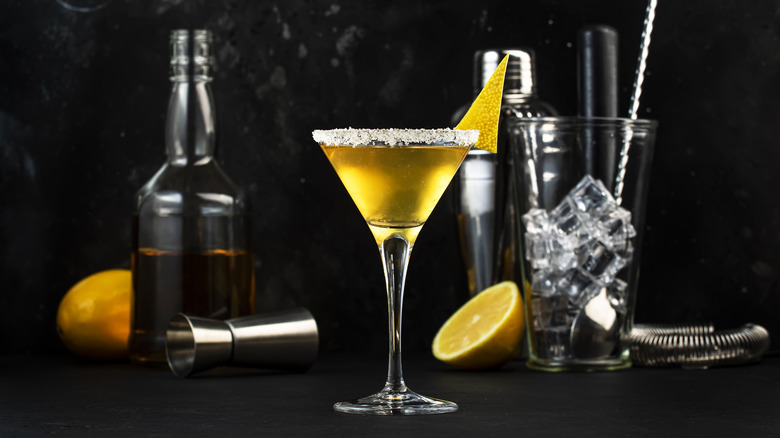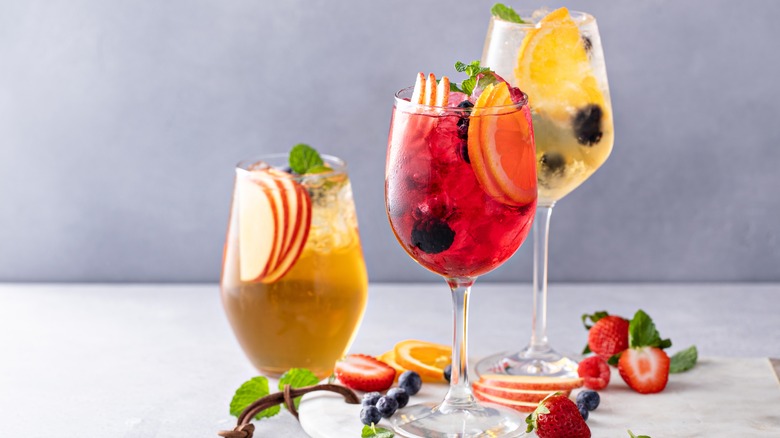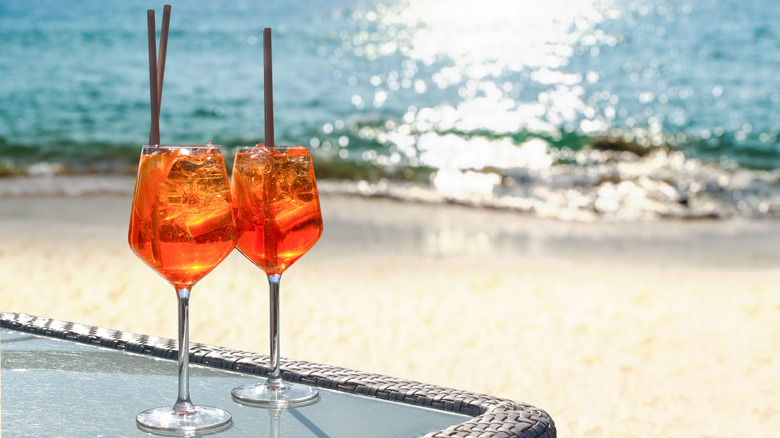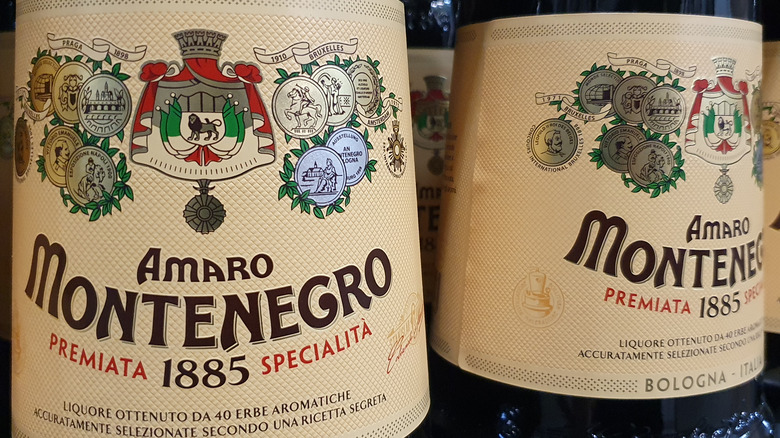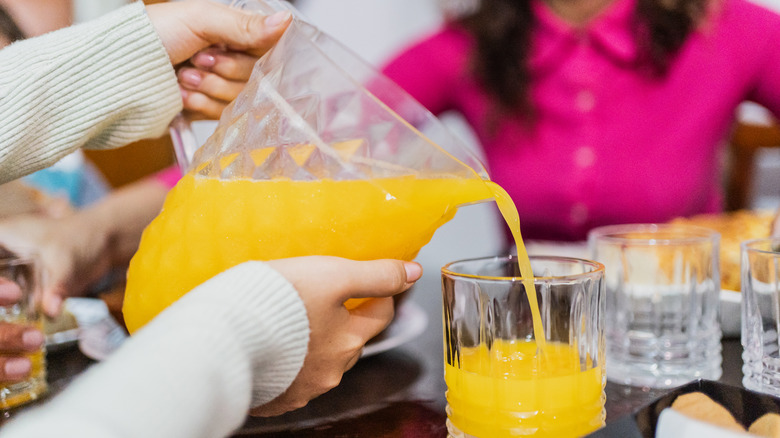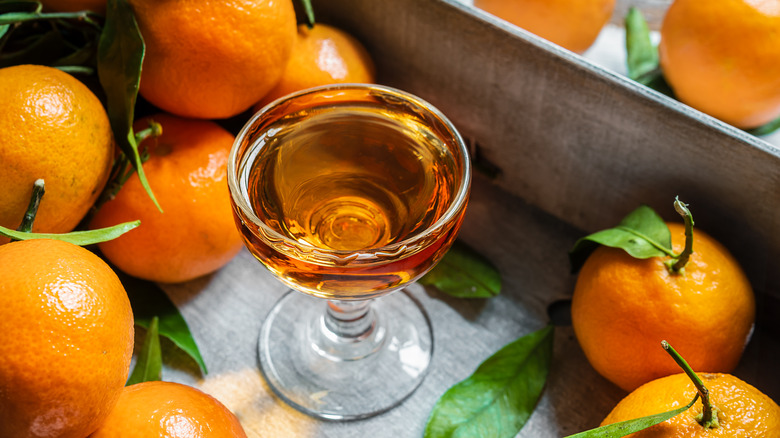What Is Triple Sec, And How Is It Different From Cointreau And Grand Marnier?
Liqueurs are a class of alcoholic drink that can really elevate your bar cart. Often ingredients in mixed cocktails, they can also be enjoyed on their own. Typically quite sweet, many liqueurs boast fruity flavors, while others can be more herbal or even bitter. Most of us don't spend a lot of time perusing the liqueur aisles at the liquor store, and it can be confusing to know what they all are and when to use them. This bottle guide can help demystify the liqueur aisle.
If you've ever tried your hand at whipping up a margarita, you've probably at least encountered triple sec. It's a type of orange liqueur that's a key ingredient in many cocktails. It's usually clear in color and sweet to taste, with a strong orange flavor. The name "triple sec" comes from the French word sec, meaning dry. It's an umbrella term, and many brands make a triple sec, ranging from cheap to rather pricey, and with alcohol content from as low as fifteen percent to as much as forty percent. Depending on the brand, that orange flavor can be more natural or artificial, purely sweet, or a little bitter.
Cointreau and Grand Marnier are perhaps the most famous iterations of orange flavor liqueur, and both are specific brand names. Cointreau is, in fact, a triple sec. These more elevated versions of orange liqueur cost a little more and have a slightly more sophisticated flavor palate than your average triple sec.
What is Cointreau and where does it come from?
Cointreau is an internationally recognized brand, and the preferred triple sec for many classic cocktails. Originating in France in the late 1800s, Cointreau won a medal at the World's Fair in Chicago in 1893, thus entering the consciousness of Americans. Ever since, its attractive dark rectangular bottle with the orange stripe has been a staple on the shelves of cocktail bars worldwide.
The Cointreau family were confectioners who decided to branch out into making liqueurs, but the recipe for this iconic orange liqueur evolved to be a little less sweet and a little more complex through its early history. Check out this ultimate bottle guide to learn more about Cointreau. It has a higher alcohol content than the average triple sec today, and a more refined reputation to match. But Cointreau is, at its core, a triple sec, and while it's nicer than many others, any old triple sec can get the job done in a pinch when you're trying to whip up a simple margarita on a budget.
Grand Marnier is a little different
Dating back to the mid 1800s, Grand Marnier is also a French brand. Louis-Alexandre Marnier Lapostolle created the original recipe by combining cognac with bitter Caribbean oranges, thus creating something quite unique at the time. The company claims that the recipe hasn't changed since 1880. The iconic bottle is instantly recognizable and features a unique shape, with a red ribbon and red seal. If you're interested in learning more about its storied history, recipe and uses, you'll find everything else you need to know about Grand Marnier in this bottle guide.
Since Grand Marnier is actually a blend of orange liqueur and cognac, it's a little different from triple sec. It's got a darker color than Cointreau and a stronger flavor, so it doesn't work in all the same cocktails, though it can sometimes be swapped in if you don't mind the touch of cognac flavor. According to the company website, Grand Marnier really became a hit in America starting in the 1970s, so it had some catching up to do with Cointreau's level of renown abroad. A drink named "The grand margarita" became a famous upgrade on the traditional margarita in the 1980s. Also known as a "Cadillac Margarita," its recipe swaps out triple sec for Grand Marnier. Similarly, a "grand Manhattan" is a twist on the classic that incorporates Grand Marnier for a little added sweetness. It's a great addition to hot chocolate too!
When do you use triple sec?
Several classic cocktail recipes call for triple sec, most famously the margarita. It's an integral part of a standard margarita recipe, which typically calls for one part triple sec to two parts tequila. The perfect margarita recipe calls for Cointreau specifically, but you can use any triple sec to get the job done. Triple sec gives a margarita its orange flavor notes, which compliment the more sour lime juice. Many other drinks like cosmopolitans, sidecars, and Long Island iced teas usually include triple sec as well. The added citrus flavor and alcohol content are integral to the drinks' overall taste and sweetness.
You can essentially use any brand of triple sec interchangeably, but the nicer ones, like Cointreau, will elevate the flavor of your drink. The elegant bottles of some triple secs will also look classier on your bar. You'll also want to keep in mind that different alcohol content levels between brands will alter the overall booziness of the drinks you make, and if you swap the triple sec out entirely, for orange juice or more simple syrup, then the cocktail's overall alcohol content will be lower. That's not necessarily a bad thing, but certainly something to be mindful of!
There are other times a splash of triple sec or Grand Marnier can come in handy
Sangria is another favorite summer drink. A mix of wine and fresh fruit, sangria recipes will often call for added sugar and a little extra boozy kick to lift the alcohol content a little. Triple sec will achieve both of these goals, adding sweetness and alcohol. A few ounces of triple sec are a great addition to your next sangria, and if you're making a white sangria, which uses white wine as its base instead of red, the clear color of triple sec won't alter the look of your drink. You can add a splash of triple sec to a mimosa to similarly boost the alcohol content and sweetness. Mimosas are already orange flavored and triple sec is a nice addition that blends well. If you're looking for a new refreshing summer drink, try this peach whiskey smash featuring Grand Marnier.
A good liqueur is designed to be sipped on its own as well. You can sip a nice orange liqueur like Cointreau or Grand Marnier after dinner as a digestif. You can also add it to a hot beverage like a coffee, or try this hot chocolate recipe with Grand Marnier. You can even incorporate orange liqueur right into a dessert recipe. Orange and chocolate are a classic combination for a reason, but this cranberry ricotta cake also uses a dash of Grand Marnier to elevate its flavors.
How long does a bottle last?
Different types of alcoholic beverages have different shelf lives. This is especially true after opening. An open bottle of beer, champagne, or prosecco, for instance, will go flat almost immediately, and a bottle of wine will start to change flavor into something rather unpleasant to drink after a few days. On the other hand, most opened bottles of liquor with high alcohol content last a few years on the shelf when stored properly.
Triple sec, Cointreau, and Grand Marnier are liqueurs, which can have an alcohol content closer to liquor, but also contain a higher sugar content. Triple sec, unopened, can last almost indefinitely on the shelf when stored properly — meaning, like most things in your liquor cabinet, it should be kept upright and away from direct sunlight, in a cool and dark spot. That opened bottle of Cointreau can also probably last a year or two when stored this way. There's no need to keep it in the fridge or freezer, although doing so will keep it nice and cold. Just make sure the lid is screwed on tight so the alcohol doesn't start to evaporate, leaving the sugars to crystalize. When in doubt, just check to see if your triple sec looks discolored or smells funky.
What is Aperol and can you use it in place of triple sec?
Aperol is another famous brand of orange flavored liqueur that's become super popular in recent years. The Aperol spritz, a mix of Aperol, sparkling wine, and soda water, has been the drink of the summer for ... going on five or six summers now? If you're tempted to pour yourself one of these refreshing, bubbly, orange bevvies, this guide will show you the correct way to pour an Aperol spritz. Many other popular cocktails, like the paper plane, use Aperol as an ingredient, but it's not exactly interchangeable with triple sec. You probably won't want to swap it into your margarita unless you're feeling experimental, that's for sure.
Aperol differs from triple sec, Cointreau, and Grand Marnier in several important ways. Firstly, it's bright orange in color. That may not always be an issue if you're adding it into your cocktail, but just know that it will definitely impact the color of your drink. Secondly, orange is only part of the flavor profile of Aperol. It's got other strong flavors, including rhubarb, quinine, and gentian that give a much more bitter component to its taste profile. It's not as far on the bitter spectrum as, say, Campari, which is a key component in a Negroni. And Campari is actually the parent company of Aperol today. They must have recognized the similarities and decided, wisely, to incorporate rather than battle their sweeter rival for orange cocktail supremacy.
Are there other orange liqueurs?
The short answer is yes! There's a wide range of different orange liqueurs out there, with a variety of flavor profiles. Some include notes of vanilla, cinnamon or the flavors of other spices. Some have more herbal notes, some are more bitter, and others are more sweet.
There is some debate over which is the best orange liqueur, and the French aren't the only ones making beautiful orange liqueurs. Italians also love a pre-dinner aperitif, or an after dinner digestif, and several Italian orange liqueurs have become staples on classy restaurant dessert menus. Amaro Nonino and Amaro Montenegro are some of the more famous ones. Not all amaros are orange flavored, and some are much more bitter than others. These are often served to be sipped, either straight up or with ice. While they have a similarly sweet and orangey flavor, they appear brown in the glass.
Substitute fresh orange juice and simple syrup
Okay, so what if that bottle of Cointreau that's been collecting dust on your bar cart has finally been emptied? Your guests are on their way over, and it's too late to run to the store, but you've promised a batch of margaritas? You can probably whip up a substitute.
The so-called "skinny" margarita typically uses a splash of orange juice in lieu of triple sec or other added sugar. This refreshing and slightly less sweet version of the classic can hit the spot on a hot day. Or, if you're not into margaritas, try making a hurricane cocktail with fresh orange juice instead. If avoiding sugar isn't your aim, however, and you simply haven't got any triple sec on the shelf, you can use a combination of orange juice and simple syrup. Alternatively, you can even add a bit of orange peel into the pot when making simple syrup to infuse it with a citrus flavor. A homemade orange simple syrup is an excellent substitute for triple sec, but using these ingredients will lower the overall alcohol content of your drink. That may be a good thing but, if you want to, you can compensate with an extra splash of tequila to keep it nice and boozy.
Make your own orange liqueur
If all this talk of orange liqueurs has piqued your culinary interest, why not try your hand at making your very own orange liqueur at home. Making a liqueur or infused liquor is much easier than it sounds. You just need a little time and a few simple ingredients. The easiest and least expensive route would be to use an inexpensive vodka, but you can also use everclear or other nicer liquors.
You want a clear, high proof alcohol as your base. You'll pour some of this into a large sterilized jar or bottle and add fresh orange peel. Any type of orange could work, but some types of orange might be better than others for making homemade triple sec. Leave these in a cool, dark place for a few weeks, maybe even a month to give the citrus plenty of time to infuse into the liquor. You'll start to see the liquor change color — just take care to avoid these mistakes everyone makes when infusing alcohol. Then, when it's ready, make a simple syrup with sugar and water and add it to the mix. Chill, and serve!
You can experiment with the flavor profile of your orange liqueur. Try this recipe that uses fresh orange peels and vanilla bean. Or pop a few cloves or a cinnamon stick into the bottle. Naturally, you can do the same with lemon peels and make a zesty limoncello instead. Either way, your guests will definitely be impressed.
